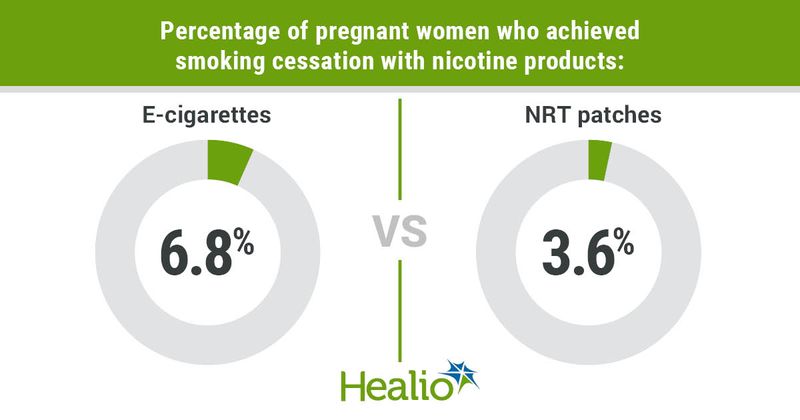Pregnant smokers more likely to quit with e-cigarettes vs. nicotine patches
Compared with nicotine patches, e-cigarettes were more effective in helping pregnant women stop smoking, according to data published in Nature Medicine.
Researchers also determined e-cigarettes and nicotine patches had similar safety profiles.

‘Objective data... are urgently needed’
Previous studies have shown nicotine replacement therapy (NRT) — including patches — and bupropion are limited in helping pregnant women stop smoking, according to the researchers. However, use of e-cigarettes for smoking cessation in pregnancy has become more popular than NRT, despite a lack of data on the safety and efficacy for women and their fetuses.
“Given that the issue [of safety] has not been definitively settled, and given that e-cigarette aerosol contains other chemicals in addition to nicotine, objective data on pregnancy outcomes in women who switch from smoking to e-cigarette use are urgently needed,” Peter Hajek, PhD, director of the health and lifestyle research unit at Queen Mary University in London, and colleagues wrote.
Study methodology
Hajek and colleagues randomly assigned pregnant women (median age, 27 years) from England and Scotland with a gestational age of 12 to 24 weeks (average, 15.7 weeks) who smoked daily and wanted to quit to either e-cigarettes or NRT patches. They instructed participants to use only their assigned product for at least the first 4 weeks of their attempt to quit.
The researchers conducted follow-up through phone calls near the end of pregnancy — upon first contact between 35 weeks’ gestation and 10 weeks after estimated delivery — and at 3 months postpartum. Calls took place between April 2018 and September 2020.
Participants were asked to provide saliva and carbon monoxide readings to validate self-reported smoking cessation.
Efficacy, safety of nicotine products
In total, 571 women in the e-cigarette arm and 569 women in the NRT arm completed follow-ups, with 196 participants reporting abstinence — 66 in the e-cigarette arm and 42 in the NRT arm. However, validation with saliva and/or carbon monoxide readings showed only 39 women (6.8%) in the e-cigarette arm and 25 (4.4%) in the NRT arm were abstinent (RR = 1.55; 95% CI, 0.95-2.53). The difference between the groups was not significant.
Of note, some women in the NRT arm also used e-cigarettes during the study. Sensitivity analyses excluding abstinent women who used products other than what they were assigned showed that e-cigarettes were significantly more effective than NRT patches (6.8% vs. 3.6%; RR = 1.93; 95 CI%, 1.14-3.26).
“However, if e-cigarette use were to persist in the long term, it is likely to carry some health risks, as well as maintaining nicotine dependence,” the researchers wrote. “In this scenario, e-cigarettes would represent a harm reduction approach.”
Adverse events and maternal and birth outcomes were similar between groups except for low birth weight, which was significantly less frequent among women in the e-cigarette arm (14.8% vs. 9.6%; RR = 0.65; 95% CI, 0.47-0.9).
“Given the questions that remain about the potential risks of nicotine in pregnancy, stopping smoking without nicotine-containing aids is preferable to switching to such products,” Hajek and colleagues concluded. “Only when the choice is between using nicotine products such as NRT or e-cigarettes or continuing to smoke, the use of NRT or e-cigarettes would be the recommended option.”

